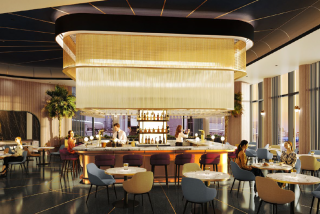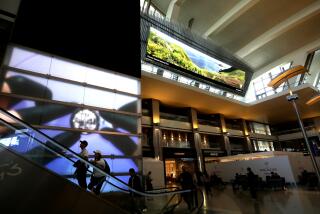Trying to Steer Clear of the Smoking Lounge
The glassed-in smoking lounges in airports are a kind of hell Dante never envisioned. Hazy, reeking and generally full of desperate-looking people, they seem far worse than the entryways of office buildings where nicotine addicts light up. At least those doorway dwellers don’t have to breathe such a concentration of secondhand smoke.
Paul G. Billings, an assistant vice president with the Washington, D.C.-based American Lung Assn., says it’s hard to quantify how much the inhalation of secondhand smoke in such airport lounges increases the risk of cancer for those who visit the toxic little rooms for one last cigarette before a flight. “It’s just a horrible environment,” he says.
Traveling is stressful, so I can see why smokers--25% of the adult population in the U.S., according to a Surgeon General’s report--would feel the need to light up between connections. I feel sorry for smokers because they are consigned to these wretched corners of airports, but as an occasional smoker, I also would rather fall into a mud puddle than visit an airport smoking lounge. Whether airports should have such lounges or be entirely smoke-free is an issue that affects anyone who trudges through the concourse.
Congress banned smoking on U.S. passenger flights of two hours or less in 1988. On June 4, 2000, smoking was officially prohibited on all scheduled passenger flights of U.S. carriers and on flights to and from the U.S. by foreign carriers.
“We sometimes forget how bad it was,” says Billings, who thinks the airline smoking ban helped galvanize public awareness about the dangers of secondhand smoke.
I vividly recall a Balkan Bulgarian Airlines flight from New York to Sofia, Bulgaria, eight years ago on which I was horrified to discover that most of the passengers chain-smoked. It was awful. I got nauseated, and I didn’t care for Sofia either.
The drive to make airports smoke-free started more than a decade ago as the various municipalities that oversee them began prohibiting smoking in public buildings. In 1991, San Francisco International was among the first to institute a no-smoking policy. At first the airport provided rooms for smokers, but these lasted only about a year. Ron Wilson, a San Francisco International Airport spokesman, says mothers took their kids into the lounges and that simply opening the door was like smoking a pack. When the ventilation system filters were removed for cleaning, they were “totally black,” Wilson says. The airport has gone to a total smoking ban, though people can smoke in a few designated areas outside.
Denver International Airport, which opened in 1995, has two interior smoking areas, one before security checkpoints and one beyond. Neither is walled off from the rest of the airport. They are equipped with ventilators that don’t attempt to purify the smoky air but exhaust it outside. They are operated by a concessionaire, which requires people to buy food or a beverage to use the areas.
Long Beach Municipal Airport, Orange County’s John Wayne Airport and Ontario International Airport prohibit smoking inside the terminals. LAX has interior courtyards in Terminals 3 and 6 to accommodate smokers; now-shelved plans for the renovation of Tom Bradley International Terminal included interior smoking lounges.
In March, when Americans for Nonsmokers’ Rights got wind of the plans to add smoking lounges at LAX and a few other major U.S. airports, the Berkeley-based nonprofit organization mounted a campaign to stop them. “Societal norms have changed,” says Cynthia Hallett, the group’s executive director. “We expect the inside of buildings to be smoke-free.”
Americans for Nonsmokers’ Rights opposes concourse smoking lounges as well as restaurants and bars with smoking areas, even if they are equipped with ventilation systems. Hallett says such systems remove odor and make smoking areas more pleasant but don’t address the health dangers of secondhand smoke.
She says cigarette manufacturer Philip Morris is partly responsible for the incorporation of such smoking areas inside airports.
Brendan McCormick, a spokesman for Philip Morris U.S.A., says the company helped finance construction of smoking lounges in airports like Las Vegas’ McCarran International in the mid-’90s as part of its Options program, which is designed to help owners of restaurants and bars (many of them inside airports) deal with the growing body of regulations limiting smoking in public places. McCormick says this largely entails offering business owners advice on how to segregate smokers from nonsmokers using, among other things, high-tech ventilation.
Customer service is enhanced when concessionaires provide comfortable places for people to smoke, McCormick says. A survey conducted last year by Airport Interviewing & Research Inc. for Philip Morris showed that 60% of passengers at 10 major U.S. airports think smokers should have a place to light up inside airports as long as such places are properly ventilated.
I know this will sound hypocritical because I’m a smoker and I think people should be able to smoke if they want to. But I also know that secondhand smoke is a potent carcinogen. Smokers should never compromise the health of people, especially children, who want nothing to do with cigarettes. So I favor smoke-free airports, having landed at cigarette-butt-strewn airports in Jordan and China and other places where smoking is tolerated. If smoking lounges and concession areas can be built so they don’t jeopardize nonsmokers, I favor them too--but not just for the sake of nonsmokers. I’d like to see the people in those awful glassed-in rooms released from the worst kind of airport hell.
More to Read
Sign up for The Wild
We’ll help you find the best places to hike, bike and run, as well as the perfect silent spots for meditation and yoga.
You may occasionally receive promotional content from the Los Angeles Times.






